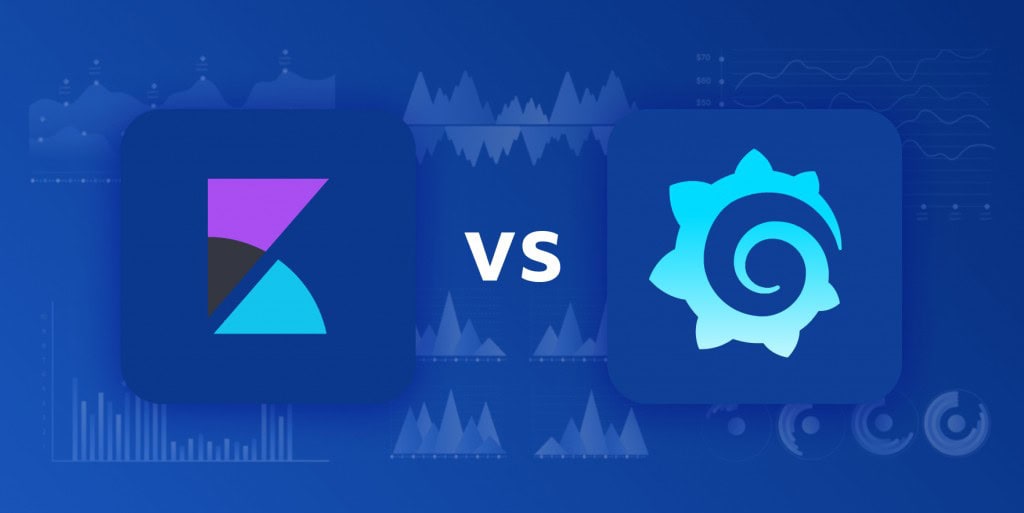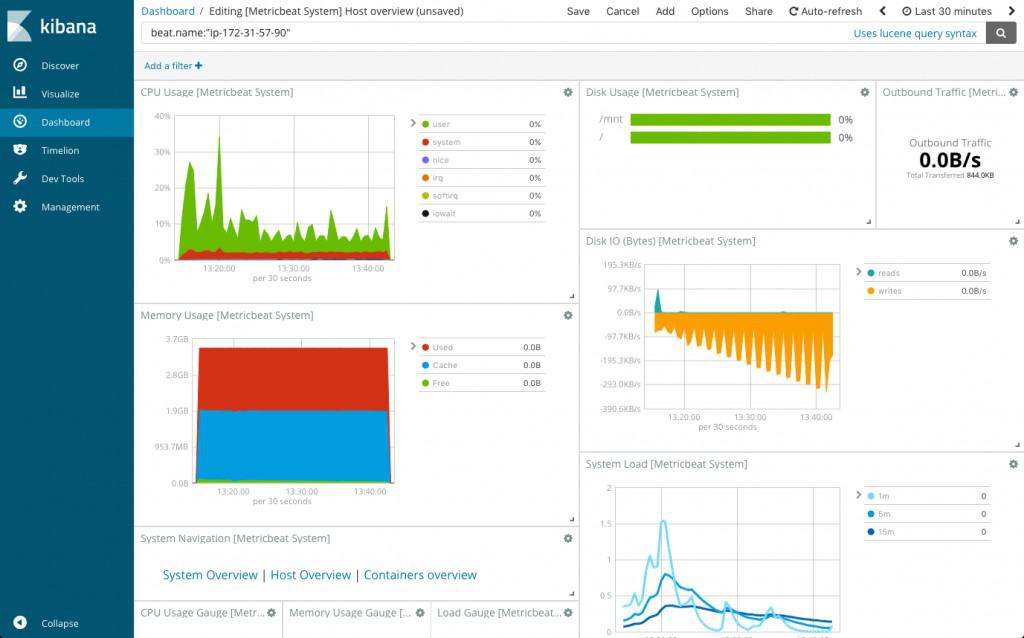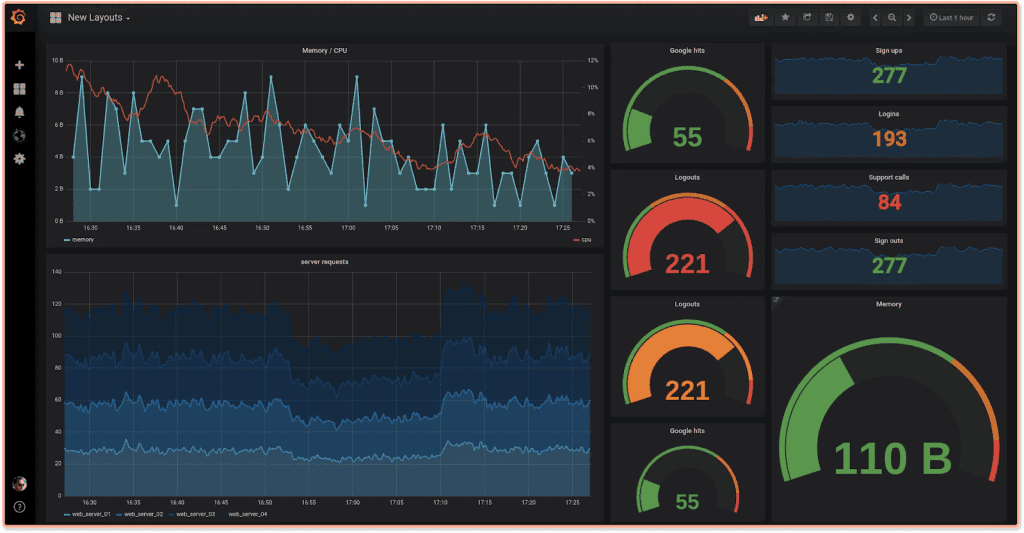
Kibana and Grafana are two of the most popular open-source platforms for data visualization and monitoring. Each has distinct strengths that make it suitable for different use cases. While Kibana is tightly integrated with the Elastic Stack, offering advanced log analysis and real-time monitoring, Grafana stands out for its ability to support a wide range of data sources, making it a versatile choice for diverse environments.
This article delves into tools’ essential features, advantages, and drawbacks to help you decide which best fits your needs. Whether you’re focused on log data analysis or broad-based metrics monitoring, understanding the nuances between Kibana and Grafana will guide you in making an informed decision. Let’s begin by exploring Kibana in more detail.
Those who possess information hold the world, especially in our era of Big Data. However, organizing and processing all the information from myriad sources in a way that brings practical benefits to business is not so simple. This challenge is why companies often turn to professional data management services, such as those offered by SoftTeco, to ensure they maximize the value derived from their data.
Kibana and Grafana are among the top open-source data visualization and monitoring platforms. Despite their similarities, each has its strengths and weaknesses, making them suitable for different situations. This article will compare Kibana vs. Grafana, examining their features, advantages, and drawbacks.
Therefore, let’s start with the overview of Kibana.
Kibana

Kibana is an open-source tool for visualizing and exploring data, mainly used for log and time-series data. Launched in 2013 by Elastic, it forms a key part of the Elastic Stack (ELK Stack), including Elasticsearch and Logstash. Kibana offers powerful search and visualization capabilities on Elasticsearch data, enabling users to create and share dynamic dashboards, graphs, and reports.
Aside from broad data visualization functionalities, Kibana is also used for:
- Log analysis: Kibana excels at filtering, searching, and visualizing log data, making it simpler to spot patterns and troubleshoot issues.
- Geospatial analysis: The platform offers robust features for geospatial data analysis. It allows users to create and visualize geospatial data on maps to ease the analysis of location-based data.
- Alerting: With Kibana, users can set up alerts to receive notifications about significant events or changes in data patterns.
- Application performance monitoring: Kibana monitors application performance and provides detailed metrics to help identify and address performance bottlenecks.
- Anomaly detection: The platform has a machine learning feature that helps to identify anomalies and reduce false positives within the data. It automatically models data behavior and detects any deviations.
The advantages of Kibana include:
- Elasticsearch integration: Kibana was explicitly built to work with Elasticsearch, making it an ideal choice for organizations leveraging the Elastic Stack.
- Open Source: Being open-source, Kibana is free to use and has a large community contributing to its development and offering support.
- Real-time monitoring: The platform enables users to monitor and track events as they occur, which helps to provide a quick response and resolve issues promptly.
- Rich visualization options: It offers a variety of visualization types, such as line charts, bar charts, heat maps, and more.
- Customizable dashboards: Kibana allows users to create personalized dashboards and reports.
These are just some of the benefits that Kibana brings to the table. However, users should also be aware of its drawbacks, which include:
- Limited data source support: Kibana is unsuitable for organizations that need to visualize data from multiple sources or databases, as you need to install plugins or APIs to use it with anything other than Elasticsearch.
- Slow performance: If not appropriately architected during the initial deployment, Kibana’s performance can be pretty slow, especially when working with large datasets.
- Learning Curve: While Kibana is user-friendly, new users may still need to fully understand its features and capabilities.
- Complex Queries: Writing complex queries in Kibana might require a good understanding of Elasticsearch Query DSL, which can be challenging for non-technical users.
Grafana

Grafana is also an open-source monitoring, visualization, and metrics analysis platform. Released in 2014, it has gained widespread adoption across various industries, offering a powerful tool for monitoring and visualizing complex data sets. Unlike Kibana, Grafana is designed to work with various data sources, including Elasticsearch, Prometheus, Graphite, and many others.
Overall, Grafana is used for:
- Monitoring: Grafana allows you to monitor the performance and health of your systems, applications, and infrastructure. It can collect data from various sources such as databases, APIs, and monitoring tools.
- Visualization: Grafana excels at visualizing time series data in various formats, such as graphs, charts, and tables. These visualizations help users understand trends, patterns, and anomalies in data, making it easier to derive insights and make data-driven decisions.
- DevOps and CI/CD: Grafana is a popular tool in DevOps pipelines for monitoring the entire CI/CD process. It helps teams track build statuses, deployment success rates, and other key metrics to ensure the efficiency and reliability of the development lifecycle.
- Annotations: Grafana allows users to add detailed annotations to graphs from various data sources. These annotations help to correlate data and identify issues if something goes awry. Users can create annotations manually or retrieve them from any data source.
- Data exploration: Grafana provides ad-hoc query capabilities, allowing users to explore their data through dynamic drill-downs. It also supports a split view and side-by-side comparison of different time ranges, queries, and data sources.
The benefits of Grafana include:
- Versatile visualization options: Grafana supports various data visualizations, allowing users to create comprehensive and easy-to-understand visual representations of their data.
- Support for multiple data sources: Grafana can integrate with multiple data sources, which helps users combine data from different environments and platforms, providing a unified view without ingesting the underlying data into Grafana’s backend.
- Alerting and notifications: Grafana has a built-in alerting system that can notify teams through email, Slack, and other sources when data deviates from predefined thresholds.
- Community and ecosystem: The community contributes plugins, dashboards, and add-ons that extend Grafana’s functionality and ease integration with other tools and platforms.
- Collaboration features: Grafana allows multiple users to collaborate on dashboards and share insights, making it suitable for team environments.
Aside from all its benefits, Grafana has some disadvantages that users should consider. That includes:
- Performance concerns: Grafana can experience performance issues when working with large volumes of data or highly complex queries, especially if the underlying data source is not optimized.
- Learning curve: Similar to Kibana, Grafana can pose some challenges and require users to invest time learning the platform, especially when setting up complex dashboards or integrations.
- Compatibility issues: While Grafana supports many popular data sources, integrating with less common databases without a native plugin can be complex.
- Dependency on external data sources: Grafana does not store data and relies on external data sources. This can be a limitation if the data source’s performance or availability is compromised.
Kibana vs. Grafana: comparison
Both Kibana and Grafana are robust visualization tools. However, their purposes are different. Grafana mainly monitors and visualizes metrics, such as system CPU, memory, and disk usage. It helps track how these elements change and perform over time, identify trends and patterns, and draw valuable insights to ensure system security.
On the other hand, Kibana is a part of Elastic Stack and was designed to explore and analyze log data. Log analysis is crucial in understanding system behavior, application performance, and other essential metrics. Kibana, with its robust features, aids in this process with its powerful search and query tools, interactive dashboards, and advanced analytical capabilities.
However, they also share some similarities. Therefore, let’s compare Kibana vs. Grafana further so you can decide what will better suit your needs.
Data source integration
Kibana is specifically designed to work solely with Elasticsearch and does not support other data sources. To utilize Kibana with data from other sources, these sources must first be ingested into the ELK stack.
Grafana, on the other hand, supports a multitude of data sources, including Graphite, Prometheus, InfluxDB, MySQL, PostgreSQL, and Elasticsearch, making it a versatile choice for organizations with diverse data storage systems. You can also expand its capabilities through plugins for additional data sources.
Access control and authentication
Regarding access control and authentication, Kibana and Grafana have different approaches. Kibana integrates seamlessly with Elasticsearch’s security features, providing robust access control mechanisms, role-based access control (RBAC), and integration with external authentication services such as Active Directory and LDAP. This makes Kibana suitable for organizations that prioritize data security and require fine-grained control over user access.
Grafana, on the other hand, offers flexible authentication options, including built-in user authentication, LDAP, OAuth, and more. While its access control capabilities are not as extensive as Kibana’s, Grafana’s focus on ease of use and flexibility makes it a popular choice for teams looking to quickly set up dashboards and share them across the organization without complex authentication requirements.
Querying
One of Kibana’s standout features is its robust log querying and searching capabilities. Users can use Lucene syntax, Kuery, and Elasticsearch Query DSL to filter, aggregate, and analyze Elasticsearch data, with results in chronological order. However, these querying languages can be challenging to learn. Besides, Elasticsearch Query DSL is exclusive to the ELK stack.
Grafana excels in time-series data analytics, making it ideal for monitoring changes over time. However, it is less optimized for exploring other data types and offers fewer querying and refining data capabilities than Kibana. Users can perform data queries through Query Editors specific to each data source, with syntax and features varying accordingly.
Visualization options
Both Kibana and Grafana offer a wide array of visualization options. The main difference lies in the process of creating dashboards.
Kibana’s visualization capabilities are tightly integrated with Elasticsearch and support various types such as line charts, bar charts, pie charts, heat maps, and geographic maps. Additionally, it offers a Canvas feature for creating pixel-perfect presentations and infographics. Its dashboards are easy to edit and customize, helping users identify trends and patterns effectively.
Grafana’s visualization options are equally comprehensive. They focus on time-series data and the ability to create dynamic, interactive dashboards. It supports various panel types, including graphs, tables, heatmaps, and free text, which can pull data from different sources. Grafana also allows the integration of custom panels through plugins, extending its visualization capabilities and making it more flexible than Kibana.
Alerting
Alerting functionality is crucial for any monitoring tool, enabling users to set up notifications for specific events or thresholds. Kibana, being an integral component of the Elastic Stack, provides alerting capabilities through its Watcher feature. Watcher allows users to create and manage alerts based on changes in data or predefined conditions. It supports sending email notifications, executing webhooks, or triggering custom integrations, making it a versatile alert tool. You can also enrich Kibana’s alerting functionalities through third-party plugins.
On the other hand, Grafana offers alerting through its built-in engine, allowing users to create alert rules based on query results. It supports various notification channels, including email, Slack, PagerDuty, and more. Grafana’s alerting capabilities are highly customizable and user-friendly, empowering users to define intricate alert conditions and actions.
Community
When comparing Grafana vs. Kibana regarding community support, both platforms boast large and active developer communities worldwide. As of 2024, Kibana has garnered 71178 commits, 19.1k stars, and approximately 800 contributors on GitHub. Grafana has accumulated over 48283 commits, 59k stars, and more than 2000 contributors on the same platform. Therefore, even though both tools offer comprehensive documentation and user-friendly interfaces, Grafana seems to be a more popular choice now.
Comprehensive comparison table
Here’s a comprehensive comparison table of Kibana vs. Grafana for better understanding:
| Parameters | Kibana | Grafana |
| Purpose and overview | Open-source tool for visualizing and exploring data, tightly integrated with Elasticsearch as part of the ELK stack. | Open-source platform for monitoring, visualization, and analysis of metrics, supports various data sources. |
| Release date | 2013 | 2014 |
| Use cases | Data visualization, log analysis, monitoring and alerting, geospatial analysis, application performance monitoring (APM). | Monitoring, visualization, alerting, data exploration. |
| Data integration | Only supports Elasticsearch within the ELK stack. | Supports multiple data sources including Elasticsearch, Prometheus, Graphite, InfluxDB, MySQL, PostgreSQL, and more through plugins. |
| Visualization | Line charts, bar charts, pie charts, heat maps, geographic maps. | Graphs, singlestat, tables, heatmaps, freetext, and more. |
| Alerting | Watcher feature for alerting within the Elastic Stack ecosystem. | Built-in alerting engine with support for various notification channels. |
| Querying | Lucene syntax, Kuery, Elasticsearch Query DSL. | Query Editors specific to each data source, varying syntax and features. |
| Access control | Integrated with Elasticsearch’s security features for robust access control. | Flexible authentication options including LDAP, OAuth, and more. |
| Ease of use | Intuitive interface but may have a steep learning curve for complex tasks. | User-friendly interface with simpler setup and dashboard creation. |
| Pros | Elasticsearch integration, open-source, real-time monitoring, rich visualization options, customizable dashboards. | Versatile visualization options, support for multiple data sources, robust alerting system, extensive community and ecosystem. |
| Cons | Limited data source support beyond Elasticsearch, potential for slow performance with large datasets, learning curve for complex queries. | Performance issues with large data volumes, learning curve for setup and integration, dependency on external data sources, less extensive access control options. |
Choosing the right tool for your needs
Both Kibana and Grafana are powerful tools for data visualization and monitoring. However, their use cases are different. Kibana offers a robust, deeply integrated solution for users with ELK Stack, providing advanced log data analysis. On the other hand, Grafana’s versatility and extensive plugin ecosystem make it a preferred choice for users with diverse data sources and comprehensive monitoring needs.
Overall, the final choice between the two depends on your specific needs, existing infrastructure, and your team’s skills. Besides, choosing only one option is unnecessary when you can use both, as they complement each other perfectly.
Daniel Raymond, a project manager with over 20 years of experience, is the former CEO of a successful software company called Websystems. With a strong background in managing complex projects, he applied his expertise to develop AceProject.com and Bridge24.com, innovative project management tools designed to streamline processes and improve productivity. Throughout his career, Daniel has consistently demonstrated a commitment to excellence and a passion for empowering teams to achieve their goals.